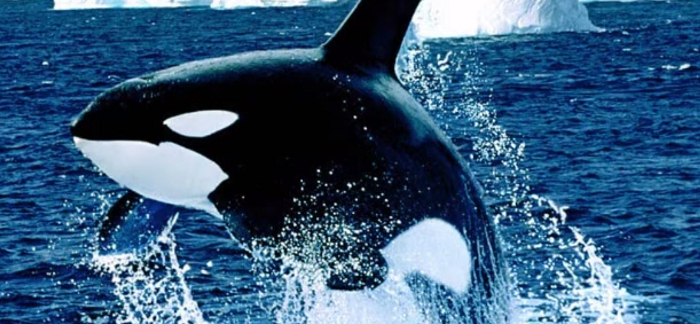Whales are some of the most fascinating creatures that inhabit the waters of the Earth. There are two basic types of whales that can be found today: toothed whales and baleen whales. Baleen whales have a fringe on their upper jaw and this helps them to strain food out of the water. These whales are the largest of the family. Toothed whales are natural predators and eat larger prey.
Whales are actually mammals. They are warm-blooded and they breathe air into their lungs just like humans do. Their children are born and feed from milk and they have hair, though there isn’t much of it. They might look like a fish and they might swim like a fish, but they are more like a human than they are like a fish.
Whales also live in all of the world’s oceans, including the Arctic and Antarctic waters at certain points throughout the year. They will often migrate over long distances from colder waters to warmer waters each year and they may travel by themselves or in pods. Here are some other important facts about whales to consider.
1. They’re Record Breaking Animals
One kind of whale, the Blue Whale, is the largest known mammal that has ever lived on the planet. It is also the largest living animal that is known to scientists so far. Blue Whales have been known to get up to 100 feet long and weigh up to 200 tons. The tongue of the Blue Whale can weigh as much as a fully grown elephant.
To support all of that weight, the Blue Whale has to eat a lot. What makes this animal unique is that it almost exclusively feeds on krill, which are a lot like tiny shrimp. There can be days where a Blue Whale can eat up to 4 tons of krill every day to support their metabolism.
Despite being large, these animals can still move quickly. They’ll usually swim at a speed of about 5 miles per hour, but when they’re not happy, they can swim as fast as 20 mph. The sounds that a Blue Whale can make are thought to be heard up to 1,000 miles away.
2. Two For the Price of One
Whales breathe through their blowholes. To make sure that water doesn’t get in there, whales also have a splashguard. If you aren’t sure if the whale that you are looking at is a toothed whale or a baleen one, then here’s another way you can tell: baleen whales have two blowholes. Toothed whales just have one blowhole.
Some whales have an incredible ability to hold their breath. Sperm Whales, for example, can hold their breath while swimming for up to 2 hours after they become adults. They can even dive pretty deep down into the water while doing this as well. Sperm Whales have been recorded at 2,000 meters, or 6,500 feet below the surface of the water.
3. Those Are Some Big Ones
The Southern Right Whale, at first glimpse, looks like any other whale that you might encounter in the water. These animals are noted for their gracefulness and many watching tours in the Southern Hemisphere are organized to watch their migratory patterns. The males are also known for one specific feature: their testicles. The testicles on the Southern Right Whale are the largest in the entire animal kingdom. Each one weighs about 2,000 pounds, or 1 ton.
The main issue that this species is facing isn’t from hunting, as other kinds of whales face, at least from humans. Gull attacks are actually increasing the mortality rate of calves. The gulls will use their beak to peck into the whale, sometimes going down several centimeters, and this gives the whale some large, open sores. The gulls do this to feed and mother whales spend a lot of energy to avoid the attacks. In return, less time is spent nursing and so the calves are malnourished.
4. Thick Blubber, If You Please
The Bowhead Whale has a lot of blubber, which is the official term for whale fat. It’s what keeps the whale warm, and since the Bowhead Whale only lives in the Arctic Ocean, it needs a lot of fat to survive. Their blubber layer has been known to be more than 2 feet thick. They also have the longest baleen of any other whale, measuring longer than a bus. This allows them to process more of the cold sea water so they can get the necessary amount of food.
5. Rainbows and Unicorns
Just because you see a rainbow doesn’t mean that you’ll find a pot of gold at the end of it. If you happen to see a horn that is being sold as a unicorn horn, the same rule applies. Male narwhals actually have just two teeth, but they are big teeth. The left tooth will pierce the animals lip and grow up to 3 meters in length. For a long time, these teeth were being sold as horns that came from unicorns.
6. That’s a Big Baby
When a whale is born, they can weigh up to 7 tons at birth. If you took 100 average men and put them together, you still might not get to the same weight as one baby whale. Most whales have a gestation period of about 12 months, but it can sometimes be shorter or longer depending on the whale species.
Baby whales can grow really fast too. Some whales can grow as fast as 8 pounds per hour when their mother is taking the proper time to nurse them. This will continue to happen for up to 8 months. Most whales will stick with their mothers for at least a year and sometimes that can be extended up to 18 months.
7. Blinded By the Candles
Whales generally take about 15 years to fully mature, but that can also vary depending on the type of whale that is being discussed. That might seem like a long time in the animal kingdom, but some species of whale can live for a long time. Some whales are thought to live upwards of 200 years, like the Bowhead whale in the Arctic Ocean.
8. Want to Take a Road Trip?
The longest migration of animals in the world belong to whales too. The longest ocean road trip belongs to the humpback whale. It feeds in the Antarctic waters when they are warmer and then will swim as far north as Panama and Colombia to reach warmer waters. It is the longest confirmed migratory pattern.
That’s not to say that they don’t have competition. Gray whales also travel a long distance during their migratory patterns as well. Some whales might travel more than 12,000 miles in order to reach their Arctic feeding grounds from the warm waters of Mexico.
What is interesting about these migratory patterns is that Northern Hemisphere whales never mix in with Southern Hemisphere whales. The migrations are times so that they are never in the same area at the same time.
9. Let’s Call it “Whaleville”
A whale might be a mammal, but it is also a floating city of life in the middle of the ocean. Whales support many different types of life. Barnacles attach to whales and live there. So do some forms of sea lice. Other animals feed off of the parasites that try to live on a whale so they can survive. Without whales, the ocean would be a very different place.
That’s why the number of whales that are poached every year, for scientific purposes or whale meat or other purposes, is very troublesome. Blue Whales, for example, once numbered above 200,000. Today there are thought to be just 3,000 whales in total. This is despite a whaling ban on them that is been in place for more than a generation.
Whale populations need a lot of time to recover. Some cultures have hunted whales for food since anyone can remember and they aren’t the problem. It’s the 25,000 whales that are killed every year for some sort of research purpose that is decimating the population of all 84 different species. It’s good to understand whales, but we need them.
10. Like a Tree Has Rings
Whales have wax plugs in their ears that build-up over time, layer by layer. When they are examined, it looks like they have rings in these plugs, just like a tree develops rings after a year of growth. By counting the number of rings that are in the ear plug, it is possible to estimate the age of a whale fairly accurately.
Unlike a yearly progress report, however, the ear wax shows when the whales are feeding and when they are migrating. Scientists can also analyze the hormones, chemicals, and minerals that are found in the ear wax. In a report of Blue Whale ear wax, it was found that the animal had been exposed to DDT when it was young, despite it being banned in 1972.
Whales are amazing creatures that are just one piece of our equally amazing planet. If we take care of them, then they’ll take care of us, and that’s the beautiful part of the cycle of life.




